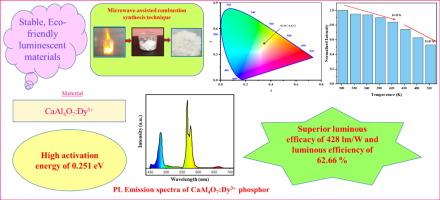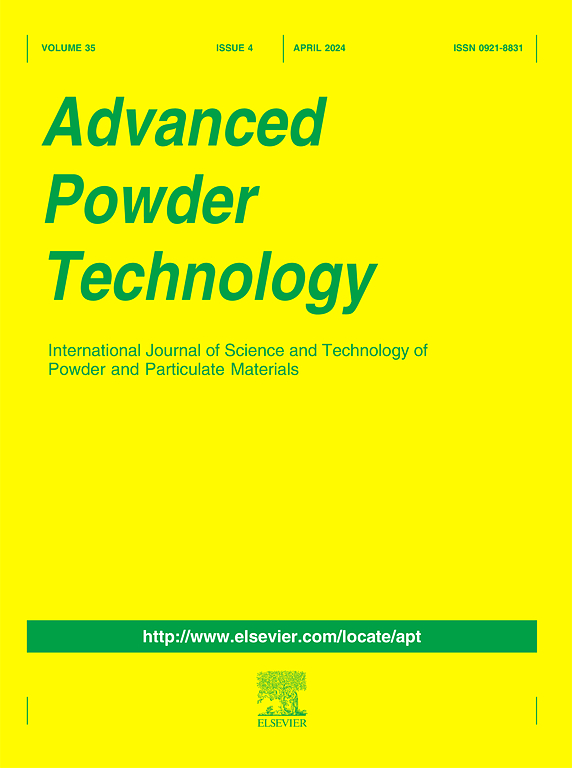Development of thermally stable, single-phased CaAl4O7:Dy3+ phosphor and a study on their down-conversion features for lighting applications
IF 4.2
2区 工程技术
Q2 ENGINEERING, CHEMICAL
引用次数: 0
Abstract
This investigation underscores the structural, optical and temperature-dependent photoluminescence characteristics of CaAl4O7:Dy3+-doped phosphor synthesized via microwave-assisted combustion synthesis route for the first time. The sample crystallizes in monoclinic structure affirmed by XRD analysis. Morphological behaviour was conducted via SEM analysis. The existence of functional groups was validated through FTIR study. Bandgap of the optimized sample was established as 4.11 eV from the UV–VIS absorbance spectra. The emission spectra possessed characteristic peaks of Dy3+ ion around 485 nm (blue), 576 nm (yellow) upon suitable excitation at 347 nm. The concentration of Dy3+ ion at x = 0.03 was established to be optimal. The CIE chromaticity co-ordinate of (x = 0.347, y = 0.427), correlated color temperature of 5109 K and color purity of 32.87 % were inferred. The PL decay time for CaAl4O7:Dy3+(x = 0.03) phosphor was obtained as 0.31 ms. Excellent thermal stability of the sample was established from the temperature-dependent PL analysis. To assess the lighting ability of the phosphor, phosphor-in-glass (P-i-G) material was fabricated. Superior luminous efficacy (428 lm/W) and luminous efficiency (62.66 %) were established for the fabricated P-i-G. The outcome vividly declares the potency of the CaAl4O7:Dy3+phosphor as a promising contender for n-UV excited phosphors for wLED applications.

开发热稳定的单相 CaAl4O7:Dy3+ 荧光粉并研究其在照明应用中的下转换特性
这项研究首次强调了通过微波辅助燃烧合成路线合成的 CaAl4O7:Dy3+ 掺杂荧光粉的结构、光学和随温度变化的光致发光特性。XRD 分析证实,样品呈单斜结构。通过 SEM 分析进行了形态学研究。傅立叶变换红外光谱研究验证了官能团的存在。通过紫外-可见吸收光谱,确定了优化样品的带隙为 4.11 eV。在 347 纳米的适当激发下,发射光谱在 485 纳米(蓝色)和 576 纳米(黄色)附近出现了 Dy3+ 离子的特征峰。Dy3+ 离子的最佳浓度为 x = 0.03。推断出 CIE 色度坐标为 (x = 0.347, y = 0.427),相关色温为 5109 K,色纯度为 32.87%。CaAl4O7:Dy3+(x = 0.03) 荧光粉的聚光衰减时间为 0.31 ms。根据随温度变化的 PL 分析,可以确定样品具有出色的热稳定性。为了评估该荧光粉的照明能力,制作了玻璃中的荧光粉(P-i-G)材料。所制造的 P-i-G 材料具有卓越的光效(428 lm/W)和发光效率(62.66%)。这一结果生动地表明,CaAl4O7:Dy3+荧光粉有望成为紫外激发荧光粉在白炽灯应用中的有力竞争者。
本文章由计算机程序翻译,如有差异,请以英文原文为准。
求助全文
约1分钟内获得全文
求助全文
来源期刊

Advanced Powder Technology
工程技术-工程:化工
CiteScore
9.50
自引率
7.70%
发文量
424
审稿时长
55 days
期刊介绍:
The aim of Advanced Powder Technology is to meet the demand for an international journal that integrates all aspects of science and technology research on powder and particulate materials. The journal fulfills this purpose by publishing original research papers, rapid communications, reviews, and translated articles by prominent researchers worldwide.
The editorial work of Advanced Powder Technology, which was founded as the International Journal of the Society of Powder Technology, Japan, is now shared by distinguished board members, who operate in a unique framework designed to respond to the increasing global demand for articles on not only powder and particles, but also on various materials produced from them.
Advanced Powder Technology covers various areas, but a discussion of powder and particles is required in articles. Topics include: Production of powder and particulate materials in gases and liquids(nanoparticles, fine ceramics, pharmaceuticals, novel functional materials, etc.); Aerosol and colloidal processing; Powder and particle characterization; Dynamics and phenomena; Calculation and simulation (CFD, DEM, Monte Carlo method, population balance, etc.); Measurement and control of powder processes; Particle modification; Comminution; Powder handling and operations (storage, transport, granulation, separation, fluidization, etc.)
 求助内容:
求助内容: 应助结果提醒方式:
应助结果提醒方式:


